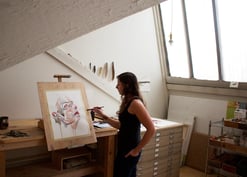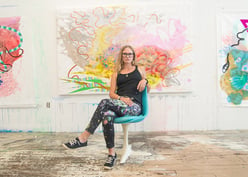TurningArtist George Rosaly’s vibrant work explores dualities, fosters connection, and welcomes the unexpected. Balancing intuition with intention, his process reflects a commitment to discipline and authenticity.
Rosaly translates emotion into form, inviting reflection and conversation. His understanding of art as a tool for communication drives him to create pieces that enrich public spaces, making art more accessible and impactful in everyday life.
Tell us about your journey to becoming a professional artist. Was there a single defining moment or a moment of clarity when you knew this was your path?
There wasn’t a single defining moment but a series of realizations that kept leading me back to the same truth.
Art was always there, even when I tried to ignore it. I used to think maybe I should follow a more conventional path, something more stable. But every time I stepped away, I felt like something was missing. One night, I was deep into a piece, completely lost in the process. Hours vanished. I stepped back to look at what I had created, and it felt like the work was alive—almost like it had a mind of its own. That was it. That was the moment I knew this wasn’t just something I did; it was something I had to do.
Tell us about your work
My work is about transformation. It’s about contrast—the balance between movement and stillness, control and chaos, rawness and refinement. I want my work to pull people in, to make them stop for a second and feel something they might not even be able to put into words. If my art sparks a thought, a memory, or even just a moment of pause, then it’s doing what it’s meant to do.
Tell us about your process
I create in layers—always pushing, evolving, sometimes even erasing before rebuilding into something new.
My process combines structure and intuition. While I might start with an idea, I also leave room for the unexpected. Some of my favorite pieces resulted from mistakes that forced me to rethink and adapt.
Stepping away is also a big part of my process. I’ll deliberately take a break and return later with fresh eyes. This strategy forces me to stay honest with my work.
When you are looking for inspiration, what resources do you turn to?
Inspiration isn’t something I chase—it’s something I let find me.
It’s in city streets, music, architecture, and the movement of light throughout the day. Sometimes, it’s in the absence of things—silence, stillness, and moments when I let my mind wander.
Travel is also a great source of influence. For example, seeing how different cultures use color and how textures appear in unexpected ways reshapes how I see everything. I also look to artists who broke rules, challenged norms, and took risks with their work. Art is supposed to push boundaries, provoke thought, and evoke emotions.
What advice do you have for staying productive and focused as an artist?
Discipline over inspiration. Every time.
If you wait for the right mood, you’ll be waiting forever. Creativity is a muscle—it needs to be exercised. Some days, the ideas flow effortlessly. On other days, it feels like I’m pulling something out of thin air. But either way, I show up because motion creates momentum.
What is your advice for combating creative blocks?
Creative blocks happen when you try to exert too much control. The best way to break them? Do something unexpected.
Change your approach. Work fast. Work slowly. Work with no goal in mind. If I feel stuck, I’ll revisit old sketches or unfinished works—sometimes the solution was already there, waiting to be seen in a different way.
Sometimes, I just step away because inspiration usually sneaks up when you stop forcing it..jpg?width=548&height=545&name=Photo%20Jan%2005%202025%2c%208%2029%2038%20PM%20(2).jpg)
As an artist, how do you measure your success?
I recognize success when my work resonates with someone in an unexpected way.
Someone once told me one of my pieces made them feel something they couldn’t explain. That meant everything to me because, at the end of the day, art is about connection.
What advice do you have for artists who are beginning to build their careers?
1. Show up. Get your work out there in any way you can.
2. Develop your own voice. Trends fade. Authenticity lasts.
3. Be adaptable. The art world is changing—embrace new ways to share and sell your work.
4. Treat it like a business. Creativity and strategy go hand in hand.
The artists who make it aren’t just talented—they’re relentless.
Do you consider yourself, and all artists, to be entrepreneurs?
Absolutely. The moment you put your work into the world and expect it to be seen, valued, or collected, you’re an entrepreneur.
Art is expression, but it’s also business. The best artists understand both.
Do you have advice for overcoming setbacks and staying resilient in the face of challenges?
Failure isn’t the opposite of success—it’s part of it.
Every rejection, every misstep—it all teaches something. The artists who succeed aren’t the ones who never fail; they’re the ones who keep going despite it.
What sparked your interest in partnering with TurningArt?
TurningArt understands that art isn’t just for collectors—it’s for people. Art should be experienced, not just displayed. That’s what makes it meaningful.
What does having your artwork in public spaces mean to you?
It’s about accessibility. Only a select few see a piece in a gallery, whereas a piece in a public space becomes part of someone’s everyday world. That’s powerful.
Was there ever a moment of clarity about being an artist?
Pursuing art wasn’t a decision—it was a realization. The moment I stopped asking 'Should I do this?' and started asking 'How do I make this my life?' was when everything changed.
How does being an artist affect your perception of the world?
Artists see details that most people overlook: the way colors interact, the patterns in everyday life, and the rhythm of movement. Everything is art when you look closely enough.
Have other artists inspired your path?
Absolutely. Inspiration isn’t just about style—it’s about philosophy. Artists who push boundaries, challenge norms, and create with conviction—those are the ones who shape my path.
What is most meaningful to you about being an artist?
The ability to create something that didn’t exist before.
Art is a way of communicating without words and translating emotions into form. It’s the closest thing we have to magic. I plan to keep creating for as long as I can.
To see more featured TurningArtists, return to our blog. To get George Rosaly's art in your space, set up a free consultation with an Art Advisor here! 




_VSCO.jpg?width=332&height=177&name=TMoss_Continuum%20Sliver%20copy%20(1)_VSCO.jpg)

